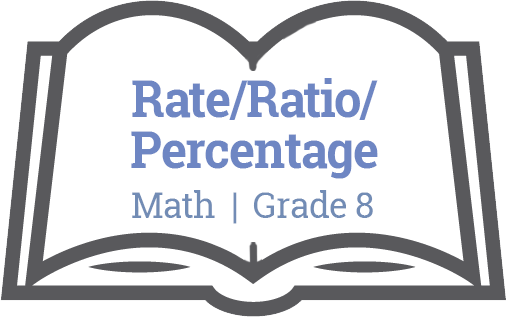
Unit Plan: Rate/Ratio/Percentage
Math / Grade 8

Big Ideas
Number represents, describes, and compares the quantities of ratios, rates, and percents.
Concepts:
- Ratios
- Rates
- Percents
Essential Questions
Students will keep considering…
- What is the best way to represent a quantity?
- What is the role of reasoning when making decisions?
Evaluative Criteria
Teacher Evaluative Criteria:
N/A
Monitoring Progress
N/A
Resources
BOOKS
- Mathlinks8 Textbook or other Math 8 Resource
- Beyond Monet by Barry Bennett
Reflection
How will teachers and their students reflect on and evaluate the completed project?
Teacher:
Next time I teach this unit I would…
Allow students to select the short stories that link to Identity.
Student:
My students needed:
Process:
Product:
Content:
Potential Student Misunderstanding:
Notes throughout lessons.
Downloads
Stage 1 – Desired Results
Big Ideas
Number represents, describes, and compares the quantities of ratios, rates, and percents.
Concepts:
- Ratios
- Rates
- Percents
Transfer Goals
Students will be able to independently use their learning to…
- Know how to use rate or ratio to compare quantities.
Meaning
Students will understand that…
-
- Comparison of quantities is key to understanding rate, ratio and percent.
Students will keep considering…
- What is the best way to represent a quantity?
- What is the role of reasoning when making decisions?
Acquisition
Students will be skilled at…
- Reasoning and analyzing
> Use reasoning and logic to explore, analyze, and apply mathematical ideas
> Model mathematics in contextualized experiences
- Understanding and solving
> Apply multiple strategies to solve problems in both abstract and contextualized situations
> Develop, demonstrate, and apply mathematical understanding through play, inquiry, and problem solving
> Visualize to explore mathematical concepts
> Communicating and representing
> Communicate mathematical thinking in many ways
> Represent mathematical ideas in concrete, pictorial, and symbolic forms
- Connecting and reflecting
> Connect mathematical concepts to each other and to other areas and personal interests
CONTENT
Students will know that…
- Percents less than 1 and greater than 100 (decimal and fractional percents)
- Numerical proportional reasoning (rates, ratio, proportions, and percent)
- Financial literacy
Which Core Competencies will be integrated into the unit?
Communication
Critical and Creative Thinking
First People's Principles of Learning
The unit will make connections with:

The following resources are made available through the British Columbia Ministry of Education. For more information, please visit BC’s New Curriculum.
Big Ideas
The Big Ideas consist of generalizations and principles and the key concepts important in an area of learning. The Big Ideas represent what students will understand at the completion of the curriculum for their grade. They are intended to endure beyond a single grade and contribute to future understanding.
Core Competencies
 Communications Competency
Communications Competency
The set of abilities that students use to impart and exchange information, experiences and ideas, to explore the world around them, and to understand and effectively engage in the use of digital media
 Thinking Competency
Thinking Competency
The knowledge, skills and processes we associate with intellectual development
 Social Competency
Social Competency
The set of abilities that relate to students’ identity in the world, both as individuals and as members of their community and society
Curricular Competencies & Content
Curricular Competencies are the skills, strategies, and processes that students develop over time. They reflect the “Do” in the Know-Do-Understand model of curriculum. The Curricular Competencies are built on the thinking, communicating, and personal and social competencies relevant to disciplines that make up an area of learning.
Additional Resources
First People's Principles of Learning
To read more about First People’s Principles of Learning, please click here.
For classroom resources, please visit the First Nations Education Steering Committee.
